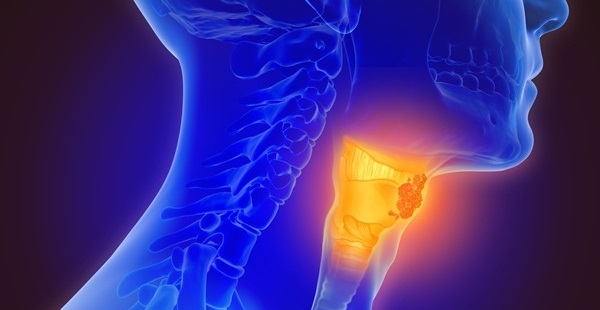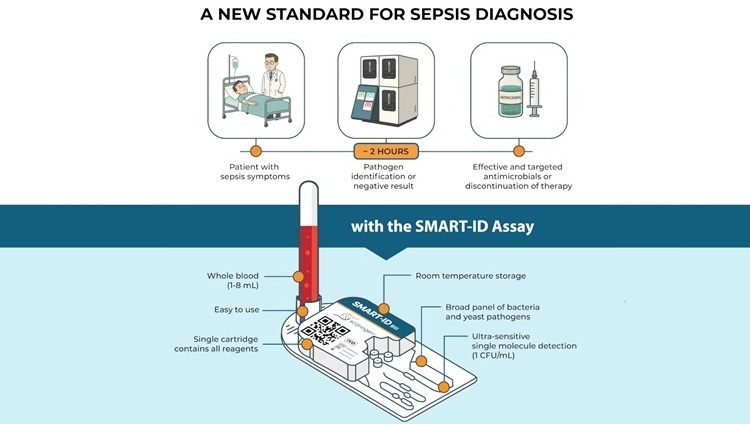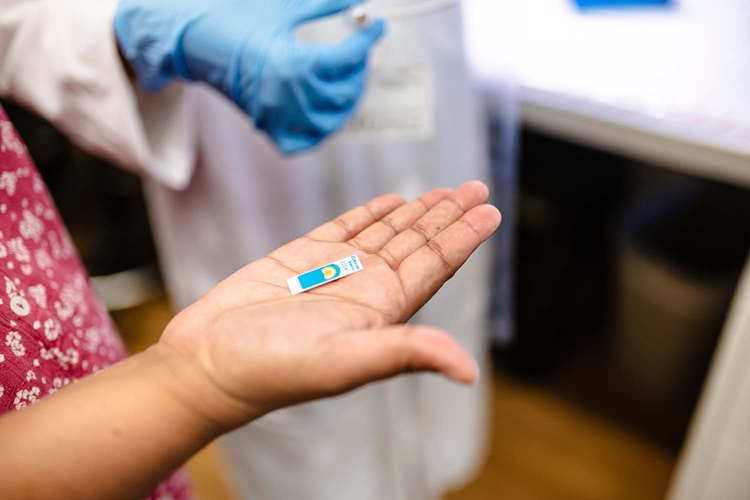Opioid Drug Abuse Testing Key Topic at Congress
|
By LabMedica International staff writers Posted on 08 Jun 2017 |
Development of new diagnostic procedures for opioid drugs and augmenting communication pathways between laboratory, clinician, and patient are important topics that will be addressed at the July 30 to August 3, 2017, AACC Annual Meeting & Clinical Lab Expo (San Diego, CA, USA).
In the United States - according to data reported in the December 2016 issue of the journal Morbidity and Mortality Weekly Report - opioids accounted for more than two-thirds of all drug overdose deaths in 2015, 15.6% more than the previous year, and drug overdose deaths nearly tripled between 1999 and 2014.
While official agencies and medical groups recommend clinical laboratory tests to support efforts aimed at curbing opioid drug abuse, many physicians may not be fully equipped with the knowledge required to interpret this test data for their patients. To help in this regard, nationally recognized centers, such as the Mayo Clinic (Rochester, MN, USA) have entered the limelight.
Physician requests for assistance in interpreting pain management tests at the Mayo Clinic increased after the [U.S.] Centers for Disease Control and Prevention (Atlanta, GA, USA) issued guidelines in March 2016 recommending urine drug testing before starting patients on opioid therapy and for monitoring them afterward. This guideline and others are driving the testing, but also leading to more confusion in terms of which type of laboratory tests to use - for example, immunoassays versus definitive methods - which specific tests to include, the frequency, and how to interpret those tests.
To help out, the Mayo Clinic now deploys many tools to help providers navigate the nuances of drug testing. Mayo’s online test catalog includes a primer on interpreting drug tests for compliance, along with short “hot topic” videos and other online educational tools.
Other institutions are also rising to the challenge. Vanderbilt University (Nashville, TN, USA) for example, now makes it possible for physicians to request interpretative services at the time they order a test.
In response to the opioid crisis, discussions at the AACC Annual Meeting will emphasize that clinical labs and their physician clients need to work together to stay abreast of drug testing needs in their local communities.
Related Links:
AACC Annual Meeting & Clinical Lab Expo
Mayo Clinic
Centers for Disease Control and Prevention
Vanderbilt University
In the United States - according to data reported in the December 2016 issue of the journal Morbidity and Mortality Weekly Report - opioids accounted for more than two-thirds of all drug overdose deaths in 2015, 15.6% more than the previous year, and drug overdose deaths nearly tripled between 1999 and 2014.
While official agencies and medical groups recommend clinical laboratory tests to support efforts aimed at curbing opioid drug abuse, many physicians may not be fully equipped with the knowledge required to interpret this test data for their patients. To help in this regard, nationally recognized centers, such as the Mayo Clinic (Rochester, MN, USA) have entered the limelight.
Physician requests for assistance in interpreting pain management tests at the Mayo Clinic increased after the [U.S.] Centers for Disease Control and Prevention (Atlanta, GA, USA) issued guidelines in March 2016 recommending urine drug testing before starting patients on opioid therapy and for monitoring them afterward. This guideline and others are driving the testing, but also leading to more confusion in terms of which type of laboratory tests to use - for example, immunoassays versus definitive methods - which specific tests to include, the frequency, and how to interpret those tests.
To help out, the Mayo Clinic now deploys many tools to help providers navigate the nuances of drug testing. Mayo’s online test catalog includes a primer on interpreting drug tests for compliance, along with short “hot topic” videos and other online educational tools.
Other institutions are also rising to the challenge. Vanderbilt University (Nashville, TN, USA) for example, now makes it possible for physicians to request interpretative services at the time they order a test.
In response to the opioid crisis, discussions at the AACC Annual Meeting will emphasize that clinical labs and their physician clients need to work together to stay abreast of drug testing needs in their local communities.
Related Links:
AACC Annual Meeting & Clinical Lab Expo
Mayo Clinic
Centers for Disease Control and Prevention
Vanderbilt University
Latest AACC 2017 News
- Siemens Healthineers Showcases Atellica Solution at AACC 2017
- Ortho Clinical Diagnostics Highlights Immunodiagnostics at Clinical Expo
- Combating Infectious Diseases Key Focus of AACC
- World's First Fully Integrated LC-MS/MS Clinical Analyzer Unveiled
- Clinical Chemistry Analyzer Provides DAU Screening
- Diatron Displays New Hematology Analyzer at UAE Congress
- Microscan Demonstrates Advanced Technology at Scientific Meeting
- AACC Middle East to Be Held in Abu Dhabi
- AACC 2017 Focus on CRISPR and Futuristic Testing Devices
- Keynote Address to Focus on CRISPR/Cas9 Gene Editing
- Winner of Qualcomm Tricorder XPrize Unveiled at AACC
- Annual Meeting Offers Industry Education and Entertainment
Channels
Clinical Chemistry
view channel
POC Breath Diagnostic System to Detect Pneumonia-Causing Pathogens
Pseudomonas aeruginosa is a major cause of hospital-acquired and ventilator-associated pneumonia, particularly in lung transplant recipients and patients with structural lung disease. Its ability to form... Read more
Online Tool Detects Drug Exposure Directly from Patient Samples
Doctors often rely on patient interviews and medical records to determine what medications a person has taken, but this information is frequently incomplete. People may forget drugs they used, take over-the-counter... Read moreMolecular Diagnostics
view channel
Blood Biomarker Improves Early Brain Injury Prognosis After Cardiac Arrest
After a cardiac arrest, many patients remain unconscious for days, leaving doctors and families facing uncertainty about whether meaningful recovery is possible. Current tools to assess brain damage, including... Read more
Biomarkers Could Identify Patients at High Risk of Severe AKI After Major Surgery
Acute kidney injury is one of the most common and dangerous complications after major surgery, particularly among patients in intensive care. Even mild impairment of kidney function can lead to long-term... Read more
CLIA Test Identifies Head and Neck Cancer Recurrence from Post-Surgical Lymphatic Fluid
While the lymphatic system’s critical role in metastasis has long been recognized, routine access to patient lymph has been elusive. Now, a non-invasive process can access lymph through the collection... Read moreHematology
view channel
MRD Tests Could Predict Survival in Leukemia Patients
Acute myeloid leukemia is an aggressive blood cancer that disrupts normal blood cell production and often relapses even after intensive treatment. Clinicians currently lack early, reliable markers to predict... Read more
Platelet Activity Blood Test in Middle Age Could Identify Early Alzheimer’s Risk
Early detection of Alzheimer’s disease remains one of the biggest unmet needs in neurology, particularly because the biological changes underlying the disorder begin decades before memory symptoms appear.... Read more
Microvesicles Measurement Could Detect Vascular Injury in Sickle Cell Disease Patients
Assessing disease severity in sickle cell disease (SCD) remains challenging, especially when trying to predict hemolysis, vascular injury, and risk of complications such as vaso-occlusive crises.... Read more
ADLM’s New Coagulation Testing Guidance to Improve Care for Patients on Blood Thinners
Direct oral anticoagulants (DOACs) are one of the most common types of blood thinners. Patients take them to prevent a host of complications that could arise from blood clotting, including stroke, deep... Read moreImmunology
view channelBlood Test Could Detect Adverse Immunotherapy Effects
Immune checkpoint inhibitors have transformed cancer treatment, but they can also trigger serious immune-related adverse events that damage healthy organs and may become life-threatening if not detected early.... Read more
Routine Blood Test Can Predict Who Benefits Most from CAR T-Cell Therapy
CAR T-cell therapy has transformed treatment for patients with relapsed or treatment-resistant non-Hodgkin lymphoma, but many patients eventually relapse despite an initial response. Clinicians currently... Read moreMicrobiology
view channel
Blood-Based Diagnostic Method Could Identify Pediatric LRTIs
Lower-respiratory tract infections (LRTIs) are a leading cause of illness and death worldwide, and pneumonia is the leading infectious cause of death in children under five, claiming the lives of over... Read more
Rapid Diagnostic Test Matches Gold Standard for Sepsis Detection
Sepsis kills 11 million people worldwide every year and generates massive healthcare costs. In the USA and Europe alone, sepsis accounts for USD 100 billion in annual hospitalization expenses.... Read moreRapid POC Tuberculosis Test Provides Results Within 15 Minutes
Tuberculosis remains one of the world’s deadliest infectious diseases, and reducing new cases depends on identifying individuals with latent infection before it progresses. Current diagnostic tools often... Read more
Rapid Assay Identifies Bloodstream Infection Pathogens Directly from Patient Samples
Bloodstream infections in sepsis progress quickly and demand rapid, precise diagnosis. Current blood-culture methods often take one to five days to identify the pathogen, leaving clinicians to treat blindly... Read morePathology
view channel
Rapid Low-Cost Tests Can Prevent Child Deaths from Contaminated Medicinal Syrups
Medicinal syrups contaminated with toxic chemicals have caused the deaths of hundreds of children worldwide, exposing a critical gap in how these products are tested before reaching patients.... Read more
Tumor Signals in Saliva and Blood Enable Non-Invasive Monitoring of Head and Neck Cancer
Head and neck cancers are among the most aggressive malignancies worldwide, with nearly 900,000 new cases diagnosed each year. Monitoring these cancers for recurrence or relapse typically relies on tissue... Read more
Common Health Issues Can Influence New Blood Tests for Alzheimer’s Disease
Blood-based tests for Alzheimer’s disease are transforming diagnosis by offering a simpler alternative to spinal taps and brain imaging. However, many people evaluated at memory clinics also live with... Read more
Blood Test Formula Identifies Chronic Liver Disease Patients with Higher Cancer Risk
Chronic liver disease affects millions worldwide and can progress silently to hepatocellular carcinoma (HCC), one of the deadliest cancers globally. While surveillance guidelines exist for patients with... Read moreTechnology
view channel
Machine Learning Models Diagnose ALS Earlier Through Blood Biomarkers
Amyotrophic lateral sclerosis (ALS) is a rapidly progressive neurodegenerative disease that is notoriously difficult to diagnose in its early stages. Early symptoms often overlap with other neurological... Read more
Artificial Intelligence Model Could Accelerate Rare Disease Diagnosis
Identifying which genetic variants actually cause disease remains one of the biggest challenges in genomic medicine. Each person carries tens of thousands of DNA changes, yet only a few meaningfully alter... Read moreIndustry
view channel
BD and Penn Institute Collaborate to Advance Immunotherapy through Flow Cytometry
BD (Becton, Dickinson and Company, Franklin Lakes, NJ, USA) has entered into a strategic collaboration with the Institute for Immunology and Immune Health (I3H, Philadelphia, PA, USA) at the University... Read more





















